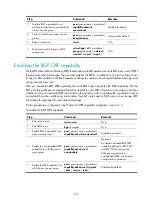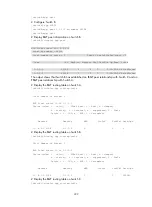
219
Configuring BGP load balancing
If multiple paths to a destination exist, you can configure load balancing over such paths to improve link
utilization.
To configure BGP load balancing:
Step Command
Remarks
1.
Enter system view.
system-view
N/A
2.
Enter BGP view.
bgp
as-number
N/A
3.
Configure the maximum number of
BGP routes for load balancing.
balance
number
Optional.
By default, Load balancing
is not enabled.
Forbidding session establishment with a peer or peer group
Step Command
Remarks
1.
Enter system view.
system-view
N/A
2.
Enter BGP view.
bgp
as-number
N/A
3.
Forbid session establishment with a
peer or peer group.
peer
{
group-name
|
ip-address
}
ignore
Optional.
Not forbidden by default.
Configuring a large scale BGP network
In a large-scale BGP network, configuration and maintenance become difficult because of the large
numbers of BGP peers. To facilitate configuration, you can configure peer group, community, route
reflector, or confederation as needed.
Configuration prerequisites
Peering nodes are accessible to each other at the network layer.
Configuring BGP peer groups
A peer group is a group of peers with the same route selection policy.
In a large-scale network, many peers may use the same route selection policy. You can configure a peer
group and add these peers into this group. In this way, peers can share the same policy as the peer
group. When the policy of the group is modified, the modification also applies to peers in it, simplifying
configuration.
A peer group is an IBGP peer group if peers in it belong to the same AS, and is an EBGP peer group if
peers in it belong to different ASs.
If a peer group has peers added, you cannot remove its AS number using the
undo
form of the command
or change its AS number.
















































